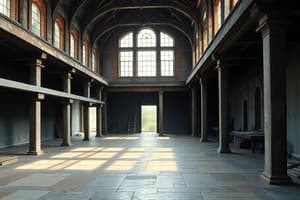Podcast
Questions and Answers
Which type of construction requires that exterior and structural members be made of noncombustible or limited combustible materials?
Which type of construction requires that exterior and structural members be made of noncombustible or limited combustible materials?
- Type IV Construction
- Type III Construction (correct)
- Type I Construction
- Type II Construction
What are the interior partitions, floors, and roofs made of in ordinary construction?
What are the interior partitions, floors, and roofs made of in ordinary construction?
- Combustible materials (correct)
- Concrete materials
- Steel materials
- Masonry materials
What are wood joists used as in ordinary construction?
What are wood joists used as in ordinary construction?
- Simple beams (correct)
- Columns
- Roof trusses
- Support beams
In ordinary construction, are the joists usually parallel or perpendicular to the street frontage of the building?
In ordinary construction, are the joists usually parallel or perpendicular to the street frontage of the building?
What is the maximum height of non-reinforced masonry walls in ordinary construction?
What is the maximum height of non-reinforced masonry walls in ordinary construction?
What is the minimum depth of exterior walls in ordinary construction?
What is the minimum depth of exterior walls in ordinary construction?
What type of walls are usually found in ordinary construction?
What type of walls are usually found in ordinary construction?
Which of the following materials is commonly used in load bearing masonry walls?
Which of the following materials is commonly used in load bearing masonry walls?
What are the most common types of stones used in construction?
What are the most common types of stones used in construction?
What are courses in masonry walls?
What are courses in masonry walls?
What is the purpose of header courses in masonry walls?
What is the purpose of header courses in masonry walls?
What design features are used for masonry walls over openings?
What design features are used for masonry walls over openings?
What is the purpose of beam pockets in masonry walls?
What is the purpose of beam pockets in masonry walls?
What is the primary benefit of masonry components in Type III Ordinary construction?
What is the primary benefit of masonry components in Type III Ordinary construction?
What is a major weakness of Type III Ordinary construction?
What is a major weakness of Type III Ordinary construction?
Flashcards are hidden until you start studying
Study Notes
Ordinary Construction
- Exterior and structural members must be made of noncombustible or limited combustible materials
- Interior partitions, floors, and roofs are made of wood or other combustible materials
- Wood joists are used as roof and floor supports
- Joists are usually parallel to the street frontage of the building
- Maximum height of non-reinforced masonry walls is 4 stories or 40 feet
- Minimum depth of exterior walls is 6 inches
- Walls are usually made of wood framing with brick or stone veneer
Masonry Walls
- Load-bearing walls are commonly made of concrete block or clay brick
- Most common types of stones used are limestone, granite, and sandstone
- Courses are horizontal layers of masonry units bound together with mortar
- Header courses are used to span openings and distribute loads
- Design features used over openings include arches, lintels, and relieving arches
- Beam pockets are recesses in masonry walls that receive the ends of beams
Type III Ordinary Construction
- Primary benefit of masonry components is their durability and fire-resistance
- Major weakness is its vulnerability to damage from earthquakes and high winds due to the weight of masonry walls
Studying That Suits You
Use AI to generate personalized quizzes and flashcards to suit your learning preferences.





